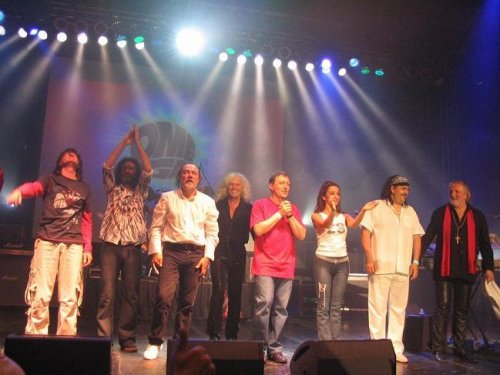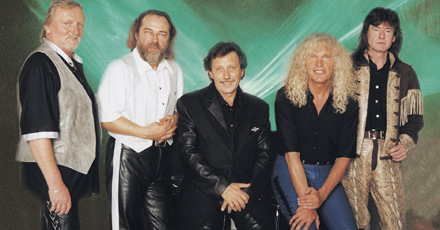| B i o g r a p h y |
 Először
főleg külföldi feldolgozásokat adtak elő. Az
Eötvös klub, majd a Kinizsi utcai, ezt követően a E klub
volt a törzshelyük. Elkészítették a "200
évvel az utolsó háború után" c.
lemezüket, de a lemezgyár nem jelentette meg az anyagot,
erre csak 1998-ban került sor. 1963-ban Láng Péter
(szaxofon) kilépett, helyére Harmat László
került. 1964-ben Wittek Mária az új énekes,
ileltve Harmat helyére Somló Tamás
érkezett, aki 1966-ban kilépett Wittekel együtt.
1967-ben az alapító Kovacsis András (gitár)
és Varsányi Iván (elektronikus bőgő)
helyére kerül Mihály és Molnár.
Angliában 1966-67-ben már kislemezeik jelentek meg.
Felléptek az 1967-es táncdalfesztiválon, ahol
Zalatnay Sarolta "Nem várok holnapig" c. dalát
kísérték. 1968-ban Presser Gábor
került az együtteshez, a nagy felállás innen
alakult ki. Ugyanebben az évben Angliában
turnéztak, a BBC-ben szerepeltek, illetve
elkészítették első (külföldi!)
nagylemezüket. Felléptek az 1968-as
táncdalfesztiválon "Kiabálj, énekelj" c.
dalukkal, de nem értek el helyezést. 1971
végén Debreceni került a csapatba, aki a Neoton
Família tagja volt. Többször lépett fel
velük Koncz Zsuzsa és Zalatnay Sarolta, ezen
kívül angol, amerikai és svéd zenészek
is játszottak az együttessel. Külföldi
útjuk során felléptek a Supertramp, Rolling
Stones, Blue Effect, Bad Company, Uriah Heep, Focus, Krokus, Golden
Earring, Whitesnake, Scorpions, Ian Gillan Band, Supermax
együttesekkel, és Bonnie Tyler énekesnővel. A
"Trombitás Frédi és a rettenetes emberek"
című lemezük az első magyar rock nagylemez volt. A
"Gyöngyhajú lány" c. daluk 1970-ben,
Japánban, a Yamaha fesztiválon fődíjat nyert.
1971-ben Kovacsics András (gitár) kilépett, sőt
Presser Gábor és Laux József is kivált a
zenekarból és megalakították a Locomotiv
Gt.-t. A hetvenes években elsősorban külföldön
turnéztak, de néha itthon is koncerteztek. 1980-ban
hosszú idő után először együtt
játszottak a Beatrice-vel és a Locomotiv Gt-vel. 1982-ben
Jancsó és Hernádi
segítségével elkészült az
"Omega, Omega" c. film, illetve Benkő László első
szólólemeze, melyeket később több
követett. 1994-ben koncertet adtak a Népstadionban.
1998-ban hosszú hallgatás után új albummal
jelentkeztek. 2006.június 3-án koncertet adtak a
Kisstadionban.
Először
főleg külföldi feldolgozásokat adtak elő. Az
Eötvös klub, majd a Kinizsi utcai, ezt követően a E klub
volt a törzshelyük. Elkészítették a "200
évvel az utolsó háború után" c.
lemezüket, de a lemezgyár nem jelentette meg az anyagot,
erre csak 1998-ban került sor. 1963-ban Láng Péter
(szaxofon) kilépett, helyére Harmat László
került. 1964-ben Wittek Mária az új énekes,
ileltve Harmat helyére Somló Tamás
érkezett, aki 1966-ban kilépett Wittekel együtt.
1967-ben az alapító Kovacsis András (gitár)
és Varsányi Iván (elektronikus bőgő)
helyére kerül Mihály és Molnár.
Angliában 1966-67-ben már kislemezeik jelentek meg.
Felléptek az 1967-es táncdalfesztiválon, ahol
Zalatnay Sarolta "Nem várok holnapig" c. dalát
kísérték. 1968-ban Presser Gábor
került az együtteshez, a nagy felállás innen
alakult ki. Ugyanebben az évben Angliában
turnéztak, a BBC-ben szerepeltek, illetve
elkészítették első (külföldi!)
nagylemezüket. Felléptek az 1968-as
táncdalfesztiválon "Kiabálj, énekelj" c.
dalukkal, de nem értek el helyezést. 1971
végén Debreceni került a csapatba, aki a Neoton
Família tagja volt. Többször lépett fel
velük Koncz Zsuzsa és Zalatnay Sarolta, ezen
kívül angol, amerikai és svéd zenészek
is játszottak az együttessel. Külföldi
útjuk során felléptek a Supertramp, Rolling
Stones, Blue Effect, Bad Company, Uriah Heep, Focus, Krokus, Golden
Earring, Whitesnake, Scorpions, Ian Gillan Band, Supermax
együttesekkel, és Bonnie Tyler énekesnővel. A
"Trombitás Frédi és a rettenetes emberek"
című lemezük az első magyar rock nagylemez volt. A
"Gyöngyhajú lány" c. daluk 1970-ben,
Japánban, a Yamaha fesztiválon fődíjat nyert.
1971-ben Kovacsics András (gitár) kilépett, sőt
Presser Gábor és Laux József is kivált a
zenekarból és megalakították a Locomotiv
Gt.-t. A hetvenes években elsősorban külföldön
turnéztak, de néha itthon is koncerteztek. 1980-ban
hosszú idő után először együtt
játszottak a Beatrice-vel és a Locomotiv Gt-vel. 1982-ben
Jancsó és Hernádi
segítségével elkészült az
"Omega, Omega" c. film, illetve Benkő László első
szólólemeze, melyeket később több
követett. 1994-ben koncertet adtak a Népstadionban.
1998-ban hosszú hallgatás után új albummal
jelentkeztek. 2006.június 3-án koncertet adtak a
Kisstadionban.
* * *
Az Omega 1962-ben alakult, s
először a kor szokásainak megfelelően külföldi
számok átültetésével aratta sikereit.
A társaság első aranycsapata - bár Somló
Tamás is megfordult soraiban (Azt mondta anyukám) -
1967-re állt össze. Ekkor Benkő László,
Kóbor János, Laux József, Mihály
Tamás, Molnár György és Presser Gábor
alkotta a zenekart. Viszonylag kevéssé köztudott,
hogy az Omega készítette az első
önálló beatzenekari lemezt Magyarországon. A
Trombitás Frédi és a Rettenetes emberek 1968-ban
látott napvilágot (Egy lány nem ment haza, Halott
virágok, Ha én szél lehetnék stb.). Az
Omega nem igazán kedvelte a Táncdalfesztiválokat.
A benne rejlő PR-lehetőség miatt 1968-ban léptek fel
önállóan, a Kiabálj, énekelj
című szerzeménnyel. Ekkora forrott ki, hogy a
Szörényi - Bródy szerzőpároshoz
hasonlóan a Presser - Adamis kettős is állandó
alkotótársként gyártotta a
slágereket (Naplemente, Régi csibészek, Ismertem
egy lányt, Ballada a fegyverkovács
fiáról). Legsikeresebb lemezük az 1969-es
Tízezer lépés lett olyan dalokkal, mint a
Petróleumlámpa, a Gyöngyhajú lány vagy
a címadó szerzemény.
Az első aranycsapat készítette még el az
Éjszakai országút című korongot 1970-ben,
amelynek borítóját az azóta
világhírűvé vált Szász Endre
tervezte. Ezután Presser és Laux távozott, az
utóbbit Debreczeni Ferenc pótolta. A másik
két zenekarhoz hasonlóan több filmszerepet kaptak,
sőt Jancsó Miklós önálló filmet
szánt az együttes bemutatására. 1971
óta az Omega nem cserélt tagot, s hosszabb-rövidebb
ideig szünetekkel mind a mai napig működő
formációt alkotnak. Következő
sikerszériájuk a hetvenes évekre tehető (Omega V.,
Nem tudom a neved, Időrabló, Csillagok útján,
Gammapolis), ekkor külföldön is komoly sikereket
arattak. Legutóbb tavaly szeptemberben léptek fel a
Népstadionban.
* * *
The most successful Hungarian rock band in history, Omega was formed in 1962 in Budapest by a group of friends. The lineup changed several times during Omega's early years and there was no consistent music style to speak of. Like with many other rock groups of the early '60s, the band's repertory largely consisted of songs by popular British bands of the period. Only in 1967, when they were joined by Gábor Presser (keyboards, vocals), did they began recording their own songs and issue a few singles. Presser's mixture of rock with elements of jazz and folk proved to be a winning formula. In 1968, John Martin, the manager of the Spencer Davis Group, invited them for a tour in Great Britain, where they recorded the album Omega: Red Star From Hungary for the Decca label. Later that year, they issued their first Hungarian LP Trombitás Frédi és a Rettenetes Emberek (Trumpeter Freddy and the Terrible People) that became their first golden album. The band sealed their success with two subsequent LPs: 10,000 Lépés (10,000 Steps) (1969) and Éjszakai Országút (On the Highway at Night) (1970). Their 1969 song "Gyöngyhajú lány" (The Girl With Pearls in Her Hair) became their first international hit and it was reworked by the Scorpions into "White Dove" in the mid-'90s.
In 1971, keyboardist Gábor Presser and drummer József Laux left the band to form another group, Locomotiv GT. Presser was an especially sensible loss since he authored most Omega compositions at the time. Also, lyricist Anna Adamis followed her husband Laux to his new band. The breakup issue was later reflected in Omega's 1971 song "Hütlen Barátok" (Unfaithful Friends). With László Benkö, who was the band's original keyboardist and then played trumpet and flute, reassuming his initial position and Ferenc Debreceni becoming the new drummer, Omega reached its final lineup: János Kóbor (vocals), Tamás Mihály (bass, vocals), Ferenc Debreceni (drums), György Molnár (guitars), and László Benkö (keyboards, vocals). While under Presser, the band's sound tended to be somewhat psychedelic and fuzzy; with the new leadership, Benkö's classically influenced keyboards and Molnár's guitar assumed a much greater focus.
 Omega's
fourth album, 200 évvel Az Utolsó Háború
Után (200 Years After the Last War) (1972), was not released due
to censorship problems. However, the band featured some songs from that
forbidden album on Elö Omega, an LP recorded with some very basic
equipment during a concert tour. The group became a frequent guest in
East Germany and even recorded some songs in German. In 1973, producer
Peter Hauke arranged a three-year contract for them with the West
German label Bacillus. To expand its potential audience, Omega began to
produce albums in two separate versions: English and Hungarian.
Beginning with Time Robber (1976) and its Hungarian counterpart,
Idörabló, released a year later, the band shifted toward
progressive rock, with lengthy instrumental interludes, surging organ
solos, and various electronic "space sounds." More albums in the
similar style followed: Skyrover (and its Hungarian version Csillagok
útján [1978]), Gammapolis/Gammapolisz (separate English
and Hungarian versions, 1979), and Working (1980) (released in Hungary
as Az Arc [The Face] [1981]). However, the band's 1980s albums began to
show the obvious signs of creative stagnation. Soon after its 13th
album, Babylon (1987), and a great concert on the occasion of the
group's 25th anniversary, Omega disbanded.
Omega's
fourth album, 200 évvel Az Utolsó Háború
Után (200 Years After the Last War) (1972), was not released due
to censorship problems. However, the band featured some songs from that
forbidden album on Elö Omega, an LP recorded with some very basic
equipment during a concert tour. The group became a frequent guest in
East Germany and even recorded some songs in German. In 1973, producer
Peter Hauke arranged a three-year contract for them with the West
German label Bacillus. To expand its potential audience, Omega began to
produce albums in two separate versions: English and Hungarian.
Beginning with Time Robber (1976) and its Hungarian counterpart,
Idörabló, released a year later, the band shifted toward
progressive rock, with lengthy instrumental interludes, surging organ
solos, and various electronic "space sounds." More albums in the
similar style followed: Skyrover (and its Hungarian version Csillagok
útján [1978]), Gammapolis/Gammapolisz (separate English
and Hungarian versions, 1979), and Working (1980) (released in Hungary
as Az Arc [The Face] [1981]). However, the band's 1980s albums began to
show the obvious signs of creative stagnation. Soon after its 13th
album, Babylon (1987), and a great concert on the occasion of the
group's 25th anniversary, Omega disbanded.
The early '90s saw the resurgence of interest in Omega. All of its albums and even previously unreleased recordings were issued on CD. In 1994, the band reunited for a big concert at the Budapest Népstadion with ex-Omega members Gábor Presser and Tamás Somló, as well as Rudolf Schenker and Klaus Meine from the Scorpions performing as guest stars. The concert was tremendously successful despite the pouring rain and it was later released on two CDs as Omegakoncert -- Népstadion 1994. Inspired by the enthusiastic reception, the musicians went on to produce a new album in 1995, Trans and Dance, and its shortened English version Transcendent (1996). The record that marked a return to Omega's hard rock roots featured contributions from Gábor Presser and guitarist Tamás Szekeres. In 1998, Omega recorded another album, Egy életre Szól. The same year, the bandmembers were distinguished with the Hungarian National Award. On September 4, 1999, Omega gave another big concert at the Népstadion that was issued on the double CD Omega Koncert Népstadion 1999.
Yuri German - All Music Guide
Official site: www.omega.hu